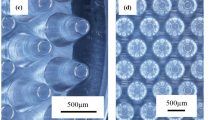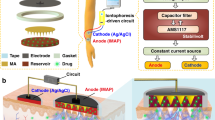Abstract
Purpose. The purpose of this study was to design and fabricate arrays of solid microneedles and insert them into the skin of diabetic hairless rats for transdermal delivery of insulin to lower blood glucose level.
Methods. Arrays containing 105 microneedles were laser-cut from stainless steel metal sheets and inserted into the skin of anesthetized hairless rats with streptozotocin-induced diabetes. During and after microneedle treatment, an insulin solution (100 or 500 U/ml) was placed in contact with the skin for 4 h. Microneedles were removed 10 s, 10 min, or 4 h after initiating transdermal insulin delivery. Blood glucose levels were measured electrochemically every 30 min. Plasma insulin concentration was determined by radioimmunoassay at the end of most experiments.
Results. Arrays of microneedles were fabricated and demonstrated to insert fully into hairless rat skin in vivo. Microneedles increased skin permeability to insulin, which rapidly and steadily reduced blood glucose levels to an extent similar to 0.05-0.5 U insulin injected subcutaneously. Plasma insulin concentrations were directly measured to be 0.5-7.4 ng/ml. Higher donor solution insulin concentration, shorter insertion time, and fewer repeated insertions resulted in larger drops in blood glucose level and larger plasma insulin concentrations.
Conclusions. Solid metal microneedles are capable of increasing transdermal insulin delivery and lowering blood glucose levels by as much as 80% in diabetic hairless rats in vivo.
Similar content being viewed by others
References
R. L. Bronaugh and H. I. Maibach. Percutaneous Absorption: Drugs—Cosmetics—Mechanisms—Methodology, Marcel Dekker, New York, 1999.
M. R. Prausnitz, S. Mitragotri, and R. Langer. Current status and future potential of transdermal drug delivery. Nat. Rev. Drug Discov. 3:115-124 (2004).
E. W. Smith and H. I. Maibach. Percutaneous Penetration Enhancers, CRC Press, Boca Raton, FL, 1995.
B. Berner and S. M. Dinh. Electronically Controlled Drug Delivery, CRC Press, Boca Raton, FL, 1998.
M. J. Jaroszeski, R. Heller, and R. Gilbert. Electrochemotherapy, Electrogenetherapy, and Transdermal Drug Delivery, Humana Press, Totowa, NJ, 1999.
J. Kost. Ultrasound-assisted insulin delivery and noninvasive glucose sensing. Diabetes Technol. Ther. 4:489-497 (2002).
S. D. Senturia. Microsystem Design, Kluwer Academic Publishers, Boston, 2001.
S. P. Davis, B. J. Landis, Z. H. Adams, M. G. Allen, and M. R. Prausnitz. Insertion of microneedles into skin: measurement and prediction of insertion force and needle fracture force. J. Biomech. (in press)
S. Henry, D. V. McAllister, M. G. Allen, and M. R. Prausnitz. Microfabricated microneedles: a novel approach to transdermal drug delivery. J. Pharm. Sci. 87:922-925 (1998).
D. V. McAllister, P. M. Wang, S. P. Davis, J. H. Park, P. J. Canatella, M. G. Allen, and M. R. Prausnitz. Microfabricated needles for transdermal delivery of macromolecules and nanoparticles: novel fabrication methods and transport studies. Proc. Natl. Acad. Sci. USA 100:13755-13760 (2003).
S. Kaushik, A. H. Hord, D. D. Denson, D. V. McAllister, S. Smitra, M. G. Allen, and M. R. Prausnitz. Lack of pain associated with microfabricated microneedles. Anesth. Analg. 92:502-504 (2001).
B. Stoeber and D. Liepmann. Fluid injection through out-of-plane microneedles. In A. Dittmar and D. Beebe (eds.), 1st Annual International IEEE-EMBS Special Topic Conference on Microtechnologies in Medicine & Biology, IEEE, Piscataway, NJ, 2000, pp. 224-228.
W. Lin, M. Cormier, A. Samiee, A. Griffin, B. Johnson, C. L. Teng, G. E. Hardee, and P. E. Daddona. Transdermal delivery of antisense oligonucleotides with microprojection patch (Macroflux) technology. Pharm. Res. 18:1789-1793 (2001).
J. A. Matriano, M. Cormier, J. Johnson, W. A. Young, M. Buttery, K. Nyam, and P. E. Daddona. Macroflux microprojection array patch technology: a new and efficient approach for intracutaneous immunization. Pharm. Res. 19:63-70 (2002).
J. A. Mikszta, J. B. Alarcon, J. M. Brittingham, D. E. Sutter, R. J. Pettis, and N. G. Harvey. Improved genetic immunization via micromechanical disruption of skin-barrier function and targeted epidermal delivery. Nat. Med. 8:415-419 (2002).
D. R. Owens. New horizons—alternative routes for insulin therapy. Nat. Rev. Drug Discov. 1:529-540 (2002).
K. B. Hensel. Electropolishing. Metal Polishing 98:440-448 (2000).
A. K. Graham. Electroplating Engineering Handbook, Van Nostrand Reinhold Co., New York, 1971.
K. C. Tomlinson, S. M. Gardiner, R. A. Hebden, and T. Bennett. Functional consequences of streptozotocin-induced diabetes mellitus, with particular reference to the cardiovascular system. Pharmacol. Rev. 44:103-150 (1992).
P. J. Rousche and R. A. Normann. A method for pneumatically inserting an array of penetrating electrodes into cortical tissue. Ann. Biomed. Eng. 20:413-422 (1992).
J. D. Bancroft and M. Gamble. Theory and Practice of Histological Techniques, Churchill Livingstone, Philadelphia, 2002.
K. Bachmann, D. Pardoe, and D. White. Scaling basic toxicokinetic parameters from rat to man. Environ. Health Perspect. 104:400-407 (1996).
D. W. Sifton. Physicians’ Desk Reference, Medical Economics Co., Montvale, NJ, 2003.
Author information
Authors and Affiliations
Corresponding author
Rights and permissions
About this article
Cite this article
Martanto, W., Davis, S.P., Holiday, N.R. et al. Transdermal Delivery of Insulin Using Microneedles in Vivo . Pharm Res 21, 947–952 (2004). https://doi.org/10.1023/B:PHAM.0000029282.44140.2e
Issue Date:
DOI: https://doi.org/10.1023/B:PHAM.0000029282.44140.2e




